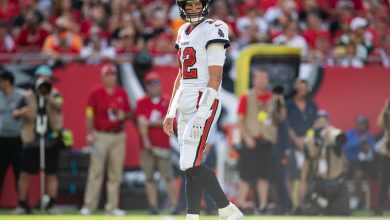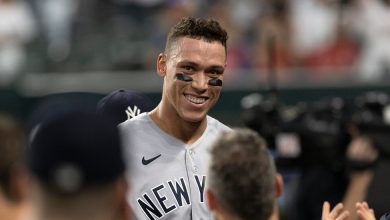N.F.L. Players Try a Different Training Camp: the Broadcast Booth

INGLEWOOD, Calif. — Sebastian Joseph-Day, a former defensive tackle for the Los Angeles Rams, scrunched his face as he recognized his mistake.
Moments earlier, ahead of Joseph-Day’s practice rep as an analyst during the N.F.L.’s broadcaster boot camp last week, an instructor reminded him to remain unbiased and not say “we” or “us” as he described the action in a recorded Rams game.
But staying neutral may have been difficult for Joseph-Day, who spent three seasons with the team. Midway through the drill, an “us” slipped, but Joseph-Day, now a Los Angeles Charger, recovered and finished the exercise cleanly.
The N.F.L. created the workshop 15 years ago, partly because players repeatedly asked for opportunities to develop as broadcasters, to network, and to make blunders in a controlled setting.
This year’s camp, hosted at the league’s West Coast headquarters, occurred amid a ripe time in the media landscape, shortly after several commentators from the N.F.L.’s major broadcast partners switched jobs, most of them signing multimillion-dollar contracts. Troy Aikman and Joe Buck exited Fox after two decades for ESPN, and Al Michaels departed NBC after 15 years to call Thursday night games for Amazon. All will reportedly earn eight figures annually.

Fitzgerald chatting with other players and former players.
The bloated salaries are products of the N.F.L.’s increasing popularity: The league’s games accounted for 48 of the 50 most-watched broadcasts in the 2021 regular season, and February’s Super Bowl recorded the game’s best ratings in five years. Players are noticing the trend and its benefits, said Larry Fitzgerald, a former Arizona Cardinals receiver who attended the program.
“The fan is watching N.F.L. games at a rate like never before, and I think that’s been seen by organizations paying top dollar for top talent,” he said.
Richard Sherman, the free agent cornerback and a camp attendee, added, “It’s definitely motivating a lot of guys, and it’s one of those places I think is going to start to get crowded.”
But none of the networks’ main play-by-play duos include a Black person and only one Black play-by-play announcer, Greg Gumbel for CBS in 2001 and 2004, has called a Super Bowl on television. Mike Tirico, who will replace Michaels at NBC, identifies as mixed race.
The lack of diversity among the talent working prime-time N.F.L. games is not ideal, said J.A. Adande, the director of sports journalism at Northwestern University.
“It’s big money and it makes you wonder who gets it and which broadcasters have these opportunities and paths available to them,” Adande said.
Tracy Perlman, the N.F.L.’s senior vice president of football operations, said she was optimistic that the camp could expand the pipeline. Media companies have long recruited former players as analysts because of their knowledge of the game and their reputations, but the list of ex-pros who failed to successfully transition to broadcasting is long and star-strewn.
Hall of Famers, including the quarterback Joe Montana and the running back Emmitt Smith, have stumbled with mics in their hands, a fate the camp is meant to prevent.
“Most people can’t just walk off the field and be in front of the camera,” Perlman said. “So we thought what could we do, especially with the partnerships that we have, to build a program that would give them those skills.”
With high demand and an aim to keep the instruction sessions small, the N.F.L. was more selective of participants than in previous years. The league sent out personal invitations and took recommendations from teams about reaching out to their players. Out of about 40 applicants, the N.F.L. chose 24 players — who were predominantly Black — based on their past experience appearing on camera and in podcasts, and their statements of interest. Faculty members included producers and hiring mangers from NBC, CBS, Fox Sports and NFL Network.
Nate Burleson, who played 11 seasons in the N.F.L. before retiring in 2014, is perhaps the camp’s most prominent alumnus. Burleson is nearly omnipresent on broadcast TV as a co-anchor for “CBS Mornings,” the network’s flagship morning news show, and host of “The NFL Today,” its weekly pregame show.
But back when he attended the camp in 2011, Burleson said he struggled in the play-by-play exercise. Though he said executives complimented him throughout the week, his performance in that drill continually irked him.
“As many reasons as the camp helped me improve who I was as a media personality, it was also honestly a slap in the face,” Burleson said.
The camp, he said, expanded his interests and made him want to become more versatile.
“It was like knowing what you wanted to do, but not having a full battery,” said Burleson, who won an Emmy award last year and was nominated for another last week. “Once you went, you were fully charged and you had direction.”
This year’s class of players spent a full day last week in classroom sessions learning about the day-to-day work flow of broadcasters and interviewing techniques. The next day, they rotated through exercises that included on-camera debates against each other. Sandy Nunez, the vice president of on-air talent management at NFL Network, said she contacted a player’s agent about a potential job opening, and was smiling in the control room while a player completed an on-camera interview.
“I can get a lot of important information here,” Nunez said, “so there’s definitely a lot of value.”
Drew Kaliski, a coordinating producer for CBS, said he enjoyed hearing smart questions from the players, and the shuffling this off-season, he said, provided good conversation for the networks to be more inclusive.
“We do definitely need to diversify our announcing teams across the board everywhere, Kaliski said. “I think having a number of people to work with is going to make everyone better, stronger, smarter and ultimately the shows will be better.”
Because of low turnover in network positions, the faculty advised players to continue to practice on their own to stay prepared, suggesting they try for on-air appearances in their local markets or on podcasts because they have a lower barrier to entry compared to national shows.
Brandon Marshall, an N.F.L. receiver for 13 seasons, echoed their advice. Marshall never attended the camp, but gained contracts with Fox Sports and Showtime and created the “I AM ATHLETE” podcast, where he and other former players debate trending topics with guests that have included Deion Sanders and Antonio Brown.
Many of the episodes, which are also filmed for streaming, have garnered millions of views on YouTube. Marshall said he believes podcasting is a nontraditional avenue his peers can capitalize on, whether or not they received formal training like the camp attendees.
“There’s only so many seats at ESPN, but the awesome part about this space is that there’s no rules,” Marshall said. “People are winning here because they’re getting outside the box.”
Sherman, for one, has followed a similar path — trying to get journalistic reps outside of national broadcast opportunities — even as he navigates his free agency. In March, he broke the news that his former teammate in Seattle, linebacker Bobby Wagner, would join the Rams in free agency via his Twitter account and has used his eponymous podcast as a platform to address everything from draft prospects to his mental health after his 2021 arrest. Sherman, who represents himself in lieu of an agent, is still training, but he also is preparing for options after his playing career.
For him, talking about football is a natural extension of the all-encompassing work of players, “like walking and talking and breathing.”
He added: “It’s one of those things where you just enjoy being around the game and continuing to be a part of it some shape or fashion.”





